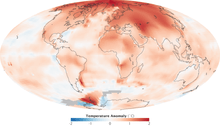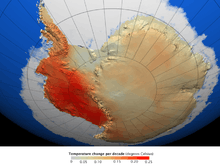Polar amplification
Polar amplification is the phenomenon that any change in the net radiation balance (for example greenhouse intensification) tends to produce a larger change in temperature near the poles than the planetary average.[1] On a planet with an atmosphere that can restrict longwave radiation to space (a greenhouse effect), surface temperatures will be warmer than a simple planetary equilibrium temperature calculation would predict. Where the atmosphere or an extensive ocean is able to convect heat polewards, the poles will be warmer and equatorial regions cooler than their local net radiation balances would predict.[2]
In the extreme, the planet Venus is thought to have experienced a very large increase in greenhouse effect over its lifetime,[3] so much so that its poles have warmed sufficiently to render its surface temperature effectively isothermal (no difference between poles and equator).[4][5] On Earth, water vapor and trace gasses provide a lesser greenhouse effect, and the atmosphere and extensive oceans provide efficient poleward heat transport. Both palaeoclimate changes and recent global warming changes have exhibited strong polar amplification, as described below.
Amplification
Amplifying mechanisms
Feedbacks associated with sea ice and snow cover are widely cited as the main cause of recent terrestrial polar amplification.[6][7] However, amplification is also observed in model worlds with no ice or snow.[8] It appears to arise both from a (possibly transient) intensification of poleward heat transport and more directly from changes in the local net radiation balance (an overall decrease in outward radiation will produce a larger relative increase in net radiation near the poles than near the equator).[8]
Some examples of climate system feedbacks thought to contribute to recent polar amplification include the reduction of snow cover and sea ice, changes in atmospheric and ocean circulation, the presence of anthropogenic soot in the Arctic environment, and increases in cloud cover and water vapor.[7] Most studies connect sea ice changes to polar amplification.[7] Some models of modern climate exhibit Arctic amplification without changes in snow and ice cover.[9] The individual processes contributing to polar warming are critical to understanding climate sensitivity.[10]
Ocean circulation
It has been estimated that 70% of global wind energy is transferred to the ocean and takes place within the Antarctic Circumpolar Current (ACC). Eventually, upwelling due to wind-stress transports cold Antarctic waters through the Atlantic surface current, while warming them over the equator, and into the Arctic environment. Thus, warming in the Arctic depends on the efficiency of the global ocean transport and plays a role in the polar see-saw effect.[11]
Decreased oxygen and low-pH during La Niña are processes that correlate with decreased primary production and a more pronounced poleward flow of ocean currents.[12] It has been proposed that the mechanism of increased Arctic surface air temperature anomalies during La Niña periods of ENSO may be attributed to the tropically excited Arctic warming mechanism (TEAM), when Rossby waves propagate more poleward, leading to wave dynamics and an increase in downward infrared radiation.[1][13]
Amplification factor
Polar amplification is quantified in terms of a polar amplification factor, generally defined as the ratio of some change in a polar temperature to a corresponding change in a broader average temperature:
- ,
where is a change in polar temperature and is, for example, a corresponding change in a global mean temperature.
Common implementations[14][15] define the temperature changes directly as the anomalies in surface air temperature relative to a recent reference interval (typically 30 years). Others have used the ratio of the variances of surface air temperature over an extended interval.[16]
Amplification phase
It is observed that Arctic and Antarctic warming commonly proceed out of phase because of orbital forcing, resulting in the so-called polar see-saw effect.[17]
Paleoclimate polar amplification
The glacial / interglacial cycles of the Pleistocene provide extensive palaeoclimate evidence of polar amplification, both from the Arctic and the Antarctic.[15] In particular, the temperature rise since the last glacial maximum 20,000 years ago provides a clear picture. Proxy temperature records from the Arctic (Greenland) and from the Antarctic indicate polar amplification factors on the order of 2.0.[15]


Recent polar amplification
Antarctic amplification
Long-term climate simulations, based on CMIP5 climate modeling, project reduced sea ice cover. However, melting of Antarctic ice sheets could change vertical ocean temperature stratification and encourage sea ice growth.[18]
Arctic amplification
The Atlantic Multi-decadal Oscillation (AMO) is highly correlated with changes in Arctic temperature, suggesting that the Atlantic Ocean thermohaline circulation is linked to temperature variability in the Arctic on a multi-decadal time scale.[19]
Extreme weather
Some studies assert a connection between rapidly warming Arctic temperatures, and thus a vanishing cryosphere, to extreme weather in mid-latitudes.[20][21][22][23] In particular, one hypothesis links polar amplification to extreme weather by changing the polar jet stream.[24] However, extreme events associated with sea ice and snow cover decline have not yet been observed for long enough to distinguish natural climate variability from impacts related to recent climate change.[25]
A study in 2014 concluded that Arctic amplification significantly decreased cold-season temperature variability over the Northern Hemisphere in recent decades. Cold Arctic air intrudes into the warmer lower latitudes more rapidly today during autumn and winter, a trend projected to continue in the future except during summer, thus calling into question whether winters will bring more cold extremes.[26]
See also
References
- 1 2 Sukyoung Lee (January 2014). [Abstract PDF "A theory for polar amplification from a general circulation perspective"] Check
|url=value (help) (PDF). Asia-Pacific Journal of Atmospheric Sciences. 50. doi:10.1007/s13143-014-0024-7. - ↑ Pierrehumbert, R. T. (2010). Principles of Planetary Climate. Cambridge University Press. ISBN 0521865565.
- ↑ Kasting, J. F. (1988). "Runaway and moist greenhouse atmospheres and the evolution of Earth and Venus". Icarus. 74 (3): 472–94. Bibcode:1988Icar...74..472K. doi:10.1016/0019-1035(88)90116-9. PMID 11538226.
- ↑ Williams, David R. (15 April 2005). "Venus Fact Sheet". NASA. Retrieved 2007-10-12.
- ↑ Lorenz, Ralph D.; Lunine, Jonathan I.; Withers, Paul G.; McKay, Christopher P. (2001). "Titan, Mars and Earth: Entropy Production by Latitudinal Heat Transport" (PDF). Ames Research Center, University of Arizona Lunar and Planetary Laboratory. Retrieved 2007-08-21.
- ↑ Hansen, J., Sato, M., & Ruedy, R. (1997). Radiative forcing and climate response. Journal of Geophysical Research: Atmospheres, 102(D6), 6831-6864
- 1 2 3 "IPCC AR5 - Near-term Climate Change: Projections and Predictability (Chapter 11 / page 983 )" (PDF). 2013.
- 1 2 Alexeev, V. A., Langen, P. L., & Bates, J. R. (2005). Polar amplification of surface warming on an aquaplanet in "ghost forcing" experiments without sea ice feedbacks. Climate Dynamics, 24(7-8), 655-666.
- ↑ Felix Pithan & Thorsten Mauritsen (February 2, 2014). "Arctic amplification dominated by temperature feedbacks in contemporary climate models". Nature Geoscience. 7 (3): 181–184. doi:10.1038/ngeo2071.
- ↑ Taylor, Patrick C., Ming Cai, Aixue Hu, Jerry Meehl, Warren Washington, Guang J. Zhang (September 23, 2013). "A Decomposition of Feedback Contributions to Polar Warming Amplification". Climate. AMS. 23 (18). doi:10.1175/JCLI-D-12-00696.1.
- ↑ Petr Chylek, Chris K. Folland, Glen Lesins, and Manvendra K. Dubey (February 3, 2010). "Twentieth century bipolar seesaw of the Arctic and Antarctic surface air temperatures" (PDF). Geophysical Research Letters. 12: 4015–4022. Bibcode:2010GeoRL..37.8703C. doi:10.1029/2010GL042793.
- ↑ Sung Hyun Nam, Hey-Jin Kim and Uwe Send (November 23, 2011). "Amplification of hypoxic and acidic events by La Niña conditions on the continental shelf off California". Geophysical Research Letters. 83. Bibcode:2011GeoRL..3822602N. doi:10.1029/2011GL049549.
- ↑ Sukyoung Lee (June 2012). "Testing of the Tropically Excited Arctic Warming Mechanism (TEAM) with Traditional El Niño and La Niña". Journal of Climate. 12: 4015–4022. doi:10.1175/JCLI-D-12-00055.1.
- ↑ Masson-Delmotte, V., M. Kageyama, P. Braconnot, S. Charbit, G. Krinner, C. Ritz, E. Guilyardi et al. (2006). "Past and future polar amplification of climate change: climate model intercomparisons and ice-core constraints". Climate Dynamics. 26 (5): 513–529. doi:10.1007/s00382-005-0081-9.
- 1 2 3 James Hansen, Makiko Sato, Gary Russell and Pushker Kharecha (September 2013). "Climate sensitivity, sea level and atmospheric carbon dioxide". Royal Society Publishing. 371 (2001). doi:10.1098/rsta.2012.0294.
- ↑ Kobashi, T., Shindell, D. T., Kodera, K., Box, J. E., Nakaegawa, T., & Kawamura, K. (2013). "On the origin of multidecadal to centennial Greenland temperature anomalies over the past 800 yr". Climate of the Past. 9 (2): 583–596. doi:10.5194/cp-9-583-2013.
- ↑ Kyoung-nam Jo, Kyung Sik Woo, Sangheon Yi, Dong Yoon Yang, Hyoun Soo Lim, Yongjin Wang, Hai Cheng & R. Lawrence Edwards (March 30, 2014). "Mid-latitude interhemispheric hydrologic seesaw over the past 550,000 years". Nature. 508 (7496): 378–382. doi:10.1038/nature13076.
- ↑ "IPCC AR5 - Near-term Climate Change: Projections and Predictability (Chapter 11 / page 996)" (PDF). 2013.
- ↑ Petr Chylek, Chris K. Folland, Glen Lesins, Manvendra K. Dubey and Muyin Wang (July 16, 2009). "Arctic air temperature change amplification and the Atlantic Multidecadal Oscillation". Geophysical Research Letters. 36. Bibcode:2009GeoRL..3614801C. doi:10.1029/2009GL038777.
- ↑ Evidence linking Arctic amplification to extreme weather in mid-latitudes 17 March 2012 Geophysical Research Letters doi:10.1029/2012GL051000
- ↑ Vladimir Petoukhov & Vladimir A. Semenov (November 2010). "A link between reduced Barents-Kara sea ice and cold winter extremes over northern continents". Journal of Geophysical Research: Atmospheres. 115 (21). Bibcode:2010JGRD..11521111P. doi:10.1029/2009JD013568.
- ↑ J A Screen (November 2013). "Influence of Arctic sea ice on European summer precipitation". Environmental Research Letters. 8 (4). doi:10.1088/1748-9326/8/4/044015.
- ↑ Qiuhong Tang, Xuejun Zhang and Jennifer A. Francis (December 2013). "Extreme summer weather in northern mid-latitudes linked to a vanishing cryosphere". Nature Climate Change. 4: 45–50. doi:10.1038/nclimate2065.
- ↑ Francis, J. A.; Vavrus, S. J. (2012). "Evidence linking Arctic amplification to extreme weather in mid-latitudes". Geophysical Research Letters. 39 (6): n/a. doi:10.1029/2012GL051000.
- ↑ James E. Overland (December 8, 2013). "Atmospheric science: Long-range linkage". Nature climate change. 4 (1): 11–12. doi:10.1038/nclimate2079.
- ↑ James A. Screen (June 15, 2014). "Arctic amplification decreases temperature variance in northern mid- to high-latitudes". Nature Climate Change. doi:10.1038/nclimate2268.